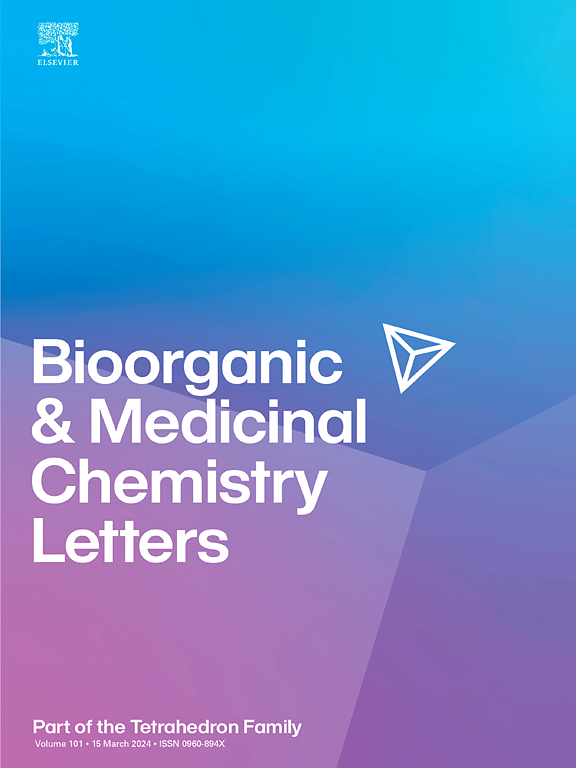神经肽S诱导炎症的外周偏置NPSR1拮抗剂的设计。
IF 2.2
4区 医学
Q3 CHEMISTRY, MEDICINAL
引用次数: 0
摘要
神经肽S (NPS)是GPCR受体NPSR1的有效激动剂,涉及多种生理和病理过程,包括炎症。NPSR1基因多态性与哮喘、炎症性肠病和子宫内膜异位症有关。NPSR1的激活通过Gαq和Gαs触发信号,分别激活钙和cAMP,诱导促炎细胞因子的表达。鉴于NPSR1在大脑中广泛表达并调节行为反应,开发具有良好药代动力学的非脑渗透NPSR1拮抗剂将是一项重大进展。虽然有希望的NPSR1拮抗剂如SHA-68R和NPSR1 - qa1存在,但不理想的ADME谱和/或脑外显率限制了NPSR1外周抑制的药理学评估。在本研究中,通过对NPSR-QA1的构效关系分析,鉴定出两种有效的外周限制性NPSR1拮抗剂,具有良好的药代动力学特性。NPSR1 - qa1衍生物在基于细胞的钙和cAMP信号分析中筛选NPSR1拮抗剂。两种先导化合物在小鼠中表现出亚纳摩尔效价、高溶解度、良好的非结合清除率和低脑穿透性。利用NPSR1强制表达的人成纤维细胞进行的体外实验发现,NPS触发了促炎标志物IL-6、PTGS2、IL-20和CXCL8的表达,这些标志物均被先导化合物有效抑制。此外,酶生蛋白诱导炎症的小鼠研究表明,NPSR1拮抗可显著增加腹膜内的巨噬细胞,降低TNF-α细胞因子水平。这些发现强调了NPSR1拮抗剂在无中枢神经系统副作用的情况下阻断炎症的潜力,推动了NPSR1拮抗剂作为外周炎症治疗剂的发展。本文章由计算机程序翻译,如有差异,请以英文原文为准。

Design of a peripherally biased NPSR1 antagonist for neuropeptide S induced inflammation
Neuropeptide S (NPS) is a potent agonist for the GPCR receptor NPSR1, implicated in various physiological and pathological processes, including inflammation. NPSR1 gene polymorphisms have been linked to asthma, inflammatory bowel disease, and endometriosis. Activation of NPSR1 triggers signaling through Gαq and Gαs leading to activation of calcium and cAMP respectively, which induces the expression of pro-inflammatory cytokines. Given NPSR1 is widely expressed in the brain and modulates behavioral responses, the development of a non-brain-penetrant NPSR1 antagonist with favorable pharmacokinetics would represent a significant advancement. While promising NPSR1 antagonists like SHA-68R and NPSR-QA1 exist, suboptimal ADME profiles and/or brain penetrance limit pharmacological evaluation of NPSR1 peripheral inhibition. In the present study, a structure-activity relationship analysis of NPSR-QA1 led to the identification of two potent, peripherally restricted NPSR1 antagonists with favorable pharmacokinetic properties. NPSR-QA1 derivatives were screened for NPSR1 antagonism in cell-based calcium and cAMP signaling assays. Two lead compounds were identified that demonstrated sub-nanomolar potency, high solubility, decent unbound clearance, and low brain penetration in mice. In vitro assays using human fibroblasts with enforced expression of NPSR1 established that NPS triggered expression of pro-inflammatory markers IL-6, PTGS2, IL-20, and CXCL8, all of which were effectively inhibited by the lead compounds. Further, murine studies with zymosan-induced inflammation showed that NPSR1 antagonism significantly increased resident macrophages in the peritoneum and reduced TNF-α cytokine levels. These findings highlight the potential of NPSR1 antagonism to block inflammation without CNS side effects, advancing the development of NPSR1 antagonists as therapeutic agents for peripheral inflammation.
求助全文
通过发布文献求助,成功后即可免费获取论文全文。
去求助
来源期刊
CiteScore
5.70
自引率
3.70%
发文量
463
审稿时长
27 days
期刊介绍:
Bioorganic & Medicinal Chemistry Letters presents preliminary experimental or theoretical research results of outstanding significance and timeliness on all aspects of science at the interface of chemistry and biology and on major advances in drug design and development. The journal publishes articles in the form of communications reporting experimental or theoretical results of special interest, and strives to provide maximum dissemination to a large, international audience.

 求助内容:
求助内容: 应助结果提醒方式:
应助结果提醒方式:


